Des interviews et des photos pour lancer la discussion
Client
Agence suisse pour le développement et la coopération DDC
Production
Concept Kuno Schläfli, Hynek Bures
Photos, interviews, sound recordings Kuno Schläfli, Lino Malizia
Histoire Aurélie de Lalande, Lino Malizia, Hynek Bures
Animations Ehud Graf
Editer Hynek Bures
2015
A successful project starts with inviting all stakeholders to discuss project goals. A video can set the stage for a fruitful discussion. The Swiss Agency for Development and Cooperation SDC office in Sofia mandated 3 videos to talk about a greater inclusion of the Roma population in Bulgaria.
The 3 videos talk about 3 aspects of social exclusion of the Roma population: on health, on education, and more generally on social integration. The videos need to balance neutrality of facts vs. established cliches, while encouraging the viewer to find solutions. To achieve this:
A – There is a distinctive story structure: Each video sets the scene (where we are, what is the problem), points towards challenges (personal stories, or past inclusion experiences), and finishes on a forward looking, solution oriented note. For example on health the video ends with young people from the Roma community making music together. Challenging the common cliche that these youngsters cannot take their future into their own hands. This first video illustrates my point (@ 7:58):
B – The interview content that found its way into the videos, reflects the many points of view present on the subject. Nevertheless the videos don’t pretend to be exhaustive. Visually this is achieved through the use of longer fade ins & outs: you open your eyes, you see something, you close them – you open them again, you see a new impression, you close them …
C – The names and roles of the interviewees is deliberately omitted. Only the credits show the names of the protagonists. The idea is to let the viewer take in the different points of view without judging the source of the message straight away: “… this one is a Roma, this one represents the government, this one is a non-Roma …”

